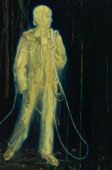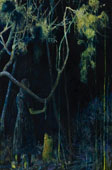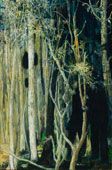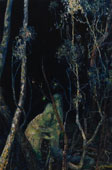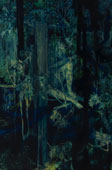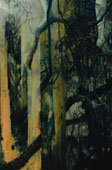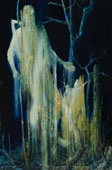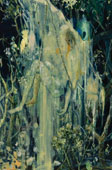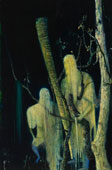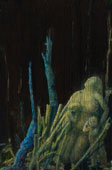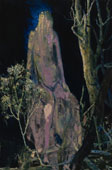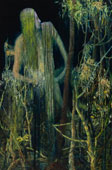The very last section of a Chinese hand scroll is called tuowei or "dragging tail," in reference to its position after the painter's work.
After the painting is first mounted on the scroll, tuowei is added as an empty space, ready to receive written responses by various people over the lifetime of the work. These colophons are usually made by writers of similar stature to the artist, by the collector [often the emperor] of the work, or even by esteemed critics who have been commissioned to undertake a considered response to the work by the owner.
In allocating Dragging Tail to this current body of paintings as a title, I am making a reference to the relationship of text or writing to the Western Australian landscape by white people since the colonial period. Early forays into the expanses of the Yilgarn craton by colonial explorers [and surveyors] would often result in a written response, or other inscribed documentation, like mapping or sketches. This process mirrors the experience of unrolling a Chinese landscape [shanshui] handscroll, travelling through the landscape, and arriving at a point where inscriptions are made.
This process of inscribing the landscape can be seen as a somewhat clumsy contrast to the refined oral transmission of knowledge in relation to country practised by aboriginal people here for thousands of years. The concrete and inflexible nature of an inscription seems inadequate to address the dynamic and complex nature of one of the oldest exposed land masses on the planet. Storytelling and other performative cultural practices such as singing, dancing and ceremony are well-suited to the ongoing changes and understanding of the depth and nuance of the land, rather than empirical forms of documentation.
Like these awkward first responses by white explorers, the spectral figures in these new paintings are struggling to move through a foreign country. Their genetic makeup is ill suited to such an encounter and their cultural education inadequate to be able to see clearly what they are moving through. In the blip of time since colonisation that has resulted in massive loss and damage to this landscape, our facility to deal with and respect the land has not advanced so much and these paintings also allude to a consequential loss and damage to the physical manifestation of a body emanating out of the Anglo-Saxon gene pool.
In some ways, these figures are attempting to learn and spend time in just being in this country, but their rudimentary tools and possessions they drag around like emotional comforters, merely inscribe an illegible text in the earth behind them.
Gregory Pryor
August 2019
|
|
|
|
|
|
|
|
|
|
|
|
- TURNER GALLERIES | showcasing contemporary art
at 470 WILLIAM STREET NORTHBRIDGE WESTERN AUSTRALIA 6003 - TURNER GALLERIES HAS NOW CLOSED.
This website is an archived record of the exhibitions and artwork shown at the gallery. - Turner Galleries acknowledges the Whadjuk Nyoongar people as the Traditional Owners of the lands and waters where Turner Galleries is situated, and pay our respect to Elders past, present and emerging.
- Website © 2000-2024 TURNER GALLERIES. All images are © the artists and are not to be used without permission.
- This is a millapede project.
